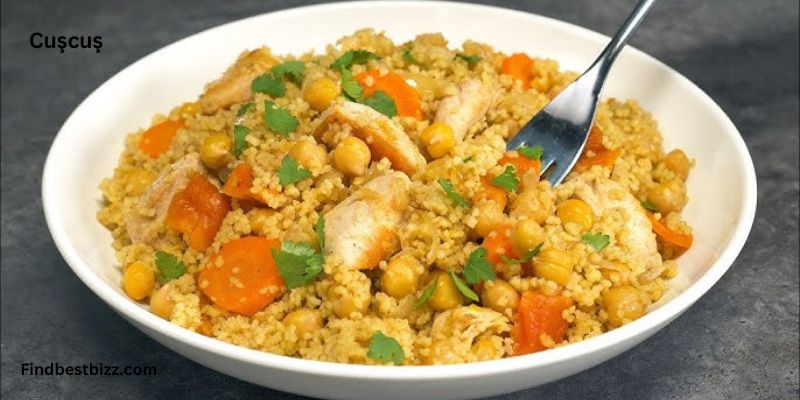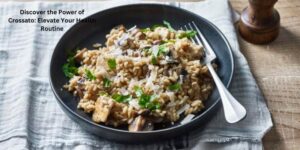
Cuşcuş
When I first discovered Cuşcuş, I was intrigued by this versatile grain dish that seemed a staple in many different cultures. Cuşcuş is delicious and incredibly nutritious, making it a perfect addition to any meal. However, I noticed that many people are unsure how to cook it properly or unaware of its various health benefits.
Learning how to prepare Cuşcuş is simpler than you might think. You can achieve the perfect texture and flavor every time with a few basic steps. Incorporating Cuşcuş into your diet can provide numerous health benefits, from aiding in weight management to supporting heart health.
If you’re curious about the history, types, and delicious recipes of Cuşcuş, keep reading. I’ll guide you through everything you need to know to make the most of this fantastic grain dish.
History and Origin of Cuşcuş
Cuşcuş, often spelled as couscous, has a rich history that dates back centuries. Originating from North Africa, it quickly became a staple food in Morocco, Algeria, Tunisia, and Libya. Traditionally made from crushed durum wheat semolina, Cuşcuş was a convenient and nourishing food for nomadic tribes. It’s fascinating to see how this humble grain dish has evolved, becoming a beloved meal across the globe. The cultural significance of Cuşcuş is profound, often associated with family gatherings and festive occasions.
In its early days, Cuşcuş was prepared by steaming over boiling water or broth, preserving its nutritional value and enhancing its fluffy texture. This cooking technique passed down through generations, is still used today, albeit with modern variations. As Cuşcuş spread across different regions, each culture added its unique twist, incorporating local ingredients and spices. This adaptability is one of the reasons Cuşcuş remains popular, reflecting the diverse culinary traditions of the areas where it’s enjoyed.
The historical journey of Cuşcuş, from North African kitchens to global cuisine, is a testament to its versatility and appeal. Understanding its origins deepens our appreciation for this dish and highlights the interconnectedness of food and culture.
Nutritional Value of Cuşcuş
Cuşcuş is a nutritional powerhouse that offers a variety of health benefits, making it an excellent addition to any diet. One cup of cooked Cuşcuş provides approximately 176 calories, making it a low-calorie option rich in essential nutrients. It is a good source of protein, with around 6 grams per cup, which is beneficial for muscle repair and growth. Additionally, Cuşcuş is high in dietary fiber, which aids in digestion and helps maintain a healthy weight.
Beyond its macronutrient content, Cuşcuş is packed with important vitamins and minerals. It contains significant amounts of selenium, an antioxidant crucial in protecting cells from damage and boosting the immune system. Cuşcuş also provides B vitamins, including thiamin, niacin, and folate, essential for energy metabolism and maintaining a healthy nervous system. The presence of iron in Cuşcuş helps in the production of red blood cells and prevents anemia.
Cuşcuş stands out from other grains like rice and quinoa due to its balanced nutrient profile and versatility in culinary applications. Incorporating Cuşcuş into your meals diversifies your diet and ensures you get a wide range of nutrients that support overall health and well-being.
Also See: Cofeemanga: Exploring the Unique Blend of Coffee and Manga
Types of Cuşcuş
Cuşcuş comes in various types, each with unique characteristics that suit different dishes and culinary traditions. The most common types are Moroccan, Israeli, and Lebanese Cuşcuş, varying in size and texture.
Moroccan Cuşcuş is the smallest and most traditional type, with a fine texture that cooks quickly. It is often used in North African dishes and pairs well with stews and braised meats due to its ability to absorb flavors.
Israeli Cuşcuş, also known as pearl Cuşcuş, is larger and has a chewy texture similar to pasta. It is often toasted before cooking, which adds a nutty flavor. This type of Cuşcuş is versatile and can be used in salads, soups, or as a side dish.
Lebanese Cuşcuş, or Moghrabieh, is the largest type and resembles small pearls. It requires a longer cooking time and is traditionally used in hearty stews and soups. Its larger size and firm texture make it a substantial addition to any meal.
Understanding the different types of Cuşcuş and their uses can help you choose the right one for your dishes, enhancing flavor and texture. Each type brings its unique qualities to the table, allowing you to explore a variety of recipes and culinary styles.
How to Cook Cuşcuş
Cooking Cuşcuş is straightforward and can be done in a few simple steps. The basic method involves hydrating the grains with hot liquid, usually water or broth, which allows them to absorb the flavors and become tender and fluffy.
To cook Moroccan Cuşcuş, start by bringing water or broth to a boil. For every cup of Cuşcuş, use one and a half cups of liquid. Once the liquid is boiling, please remove it from heat, stir in the Cuşcuş, cover, and let it sit for about 5 minutes. Afterward, fluff the Cuşcuş with a fork to separate the grains.
Israeli Cuşcuş, on the other hand, benefits from toasting before hydrating. Toast the grains in a bit of oil until golden brown, then add water or broth (using a 1:1.5 ratio) and simmer for about 10 minutes until the liquid is absorbed.
For Lebanese Cuşcuş, which takes longer to cook, you’ll need to simmer it in broth for about 20 minutes or until the grains are tender. This type of Cuşcuş works well in soups and stews, where it can absorb the rich flavors of the dish.
Following these steps will ensure you achieve perfect Cuşcuş every time. Experimenting with different liquids and seasonings can enhance flavor and make your Cuşcuş dishes more interesting and delicious.
Popular Cuşcuş Recipes
Exploring different recipes can help you appreciate the versatility of Cuşcuş. Here are three popular dishes that showcase its unique qualities:
Traditional Moroccan Cuşcuş: This dish features a flavorful blend of spices, vegetables, and meats. To prepare, cook Cuşcuş according to the basic method and set aside. In a separate pot, sauté onions, garlic, and a mix of spices like cumin, coriander, and cinnamon. Add chopped vegetables and meat (chicken or lamb) and cook until tender. Serve the stew over the Cuşcuş, garnished with fresh herbs and lemon wedges.
Mediterranean Cuşcuş Salad: This refreshing salad is perfect for a light meal or side dish. Cook Cuşcuş and let it cool. Mix the Cuşcuş with diced cucumbers, tomatoes, red onions, and olives in a large bowl. Add crumbled feta cheese and chopped fresh herbs like parsley and mint. Dress with olive oil, lemon juice, salt, and pepper. Toss everything together and serve chilled.
Cuşcuş with Vegetables and Chickpeas: A vegetarian delight, this dish is both nutritious and satisfying. Start by cooking Cuşcuş and set it aside. In a pan, sauté a mix of bell peppers, zucchini, and carrots until tender. Add canned chickpeas and season with spices like paprika, cumin, and turmeric. Combine the vegetable mixture with the Cuşcuş and garnish with fresh cilantro.
These recipes highlight the diverse ways Cuşcuş can be incorporated into your meals, providing a delicious and nutritious addition to your culinary repertoire.
Cuşcuş in Different Cuisines
Cuşcuş has made its way into various cuisines, each adding its unique twist to this versatile grain. In North African cuisine, Cuşcuş is a staple, often served with rich stews and tagines. Moroccan Cuşcuş, in particular, is renowned for its aromatic spices and hearty ingredients, creating a flavorful and satisfying meal.
In Mediterranean cuisine, Cuşcuş is frequently used in salads and light dishes. Its ability to absorb flavors makes it an ideal base for fresh vegetables, herbs, and cheeses. Mediterranean Cuşcuş salads are popular for their vibrant colors and refreshing taste, often served as a side dish or a light lunch.
Modern culinary adaptations have also embraced Cuşcuş, incorporating it into contemporary dishes. Chefs experiment with Cuşcuş in various forms, from using it as a vegetable stuffing to creating gourmet desserts. The grain’s adaptability allows it to blend seamlessly with different ingredients and cooking styles.
The presence of Cuşcuş in these diverse cuisines highlights its universal appeal and versatility. Whether you’re enjoying a traditional North African dish or a modern twist, Cuşcuş brings a unique texture and flavor to the table, enriching your culinary experience.
Cuşcuş as a Healthy Alternative
Cuşcuş is often compared to other grains like rice, quinoa, and pasta, but it stands out due to its balanced nutritional profile and versatility. As a healthy alternative, Cuşcuş offers several advantages, particularly those looking to diversify their diet or manage their weight.
Compared to white rice, Cuşcuş is lower in calories and higher in fiber, making it a more filling option that can aid in weight management. It also has a lower glycemic index, which means it has a slower impact on blood sugar levels, which benefits those monitoring their glucose intake.
Compared to quinoa, Cuşcuş may not have as much protein, but it still provides a decent amount of this essential nutrient. Additionally, Cuşcuş is often more affordable and easier to prepare, making it a convenient choice for quick meals.
Cuşcuş also serves as a great substitute for pasta, offering a similar texture but fewer calories and carbohydrates. This makes it an excellent option for those following a low-carb diet or looking to reduce their calorie intake.
Incorporating Cuşcuş as a healthy meal alternative can provide various nutritional benefits while keeping your diet interesting and diverse.
Also See: Discover the Power of Crossato: Elevate Your Health Routine
Cuşcuş for Special Diets
Cuşcuş is incredibly adaptable, making it suitable for various special diets. Whether following a vegan, vegetarian, or low-carb diet, Cuşcuş can be easily incorporated into your meals with delicious results.
For vegans and vegetarians, Cuşcuş is a versatile base for various plant-based dishes. It pairs well with various vegetables, legumes, and plant-based proteins. For instance, a vegan Cuşcuş salad with roasted vegetables and chickpeas offers a nutritious and satisfying meal rich in fiber and protein.
For those on a low-carb diet, Cuşcuş can be enjoyed in moderation. While it does contain carbohydrates, you can opt for smaller portions or pair it with low-carb vegetables and proteins to balance your meal. Additionally, there are alternative versions of Cuşcuş made from cauliflower or other low-carb ingredients that mimic the texture and flavor of traditional Cuşcuş.
Meal prepping with Cuşcuş is also an excellent option for busy individuals. It cooks quickly and can be stored in the refrigerator for several days, making it easy to prepare in advance. This allows you to have healthy, ready-to-eat meals throughout the week, saving time and effort.
No matter your dietary preferences, Cuşcuş can be adapted to fit your needs, providing a delicious and nutritious addition to your meal plan.
Buying and Storing Cuşcuş
When buying Cuşcuş, selecting high-quality grains is important to ensure the best flavor and texture. Look for Cuşcuş that is uniform in size and free from any signs of moisture or clumping. Whole grain Cuşcuş is a great option as it retains more nutrients than the refined version.
Once you’ve purchased Cuşcuş, proper storage is key to maintaining its freshness. Store Cuşcuş in an airtight container in a cool, dry place away from direct sunlight. This helps prevent moisture and pests from affecting the grains. Properly stored Cuşcuş can last several months, making it a convenient pantry staple.
If you’ve cooked a large batch of Cuşcuş, it can be stored in the refrigerator for up to five days. Ensure it is kept in an airtight container to maintain its moisture and prevent it from drying out. Reheating Cuşcuş is simple – add a splash of water or broth and heat it in the microwave or stove until warm.
Following these tips ensures that your Cuşcuş remains fresh and ready to use in various dishes. Whether preparing a quick weeknight dinner or planning a special meal, having high-quality Cuşcuş on hand makes meal preparation easier and more enjoyable.
Conclusion
Incorporating Cuşcuş into your meals can open up a world of culinary possibilities. Its rich history, nutritional benefits, and versatility make it a valuable addition to any diet. From traditional North African dishes to modern culinary creations, Cuşcuş offers a unique texture and flavor that can enhance your cooking repertoire.
I encourage you to try the recipes in this article and explore new ways to enjoy Cuşcuş. Whether you’re looking for a nutritious meal, a quick side dish, or a creative addition to your culinary experiments, Cuşcuş is a grain that delivers on all fronts.
Start experimenting with Cuşcuş today and discover how this ancient grain can bring new life to your meals. Share your creations and experiences, and continue exploring the endless possibilities that Cuşcuş offers.
FAQs:
What is Cuşcuş made of?
Cuşcuş is typically made from durum wheat semolina. The semolina is mixed with water to form small granules, which are dried and often steamed before cooking. Whole grain versions are also available, offering additional nutritional benefits.
Is Cuşcuş gluten-free?
Traditional Cuşcuş made from wheat is not gluten-free. However, gluten-free alternatives made from other grains like corn, rice, or even cauliflower mimic the texture and appearance of traditional Cuşcuş.
How can I make Cuşcuş more flavorful?
To enhance the flavor of Cuşcuş, cook it in broth instead of water and add spices, herbs, and aromatics. Toasting the grains before hydrating can also add a nutty flavor. Incorporating vegetables, meats, or sauces can further enrich the dish.
What are the health benefits of Cuşcuş?
Cuşcuş is low in calories and fiber, making it a good choice for weight management. It is also a source of protein, vitamins (such as B vitamins), and minerals (including selenium and iron), contributing to overall health and wellness.
Can I use Cuşcuş in desserts?
Yes, Cuşcuş can be used in desserts. Its mild flavor and fluffy texture make it a suitable base for sweet dishes. Combining it with fruits, nuts, honey, or spices creates delicious and unique desserts.
Also See: The Many Layers of Çeciir: From Cuisine to Culture







